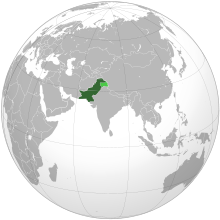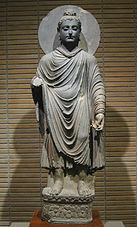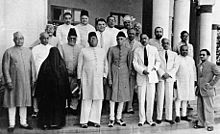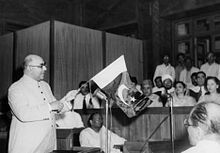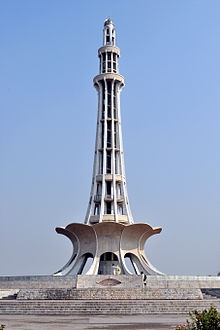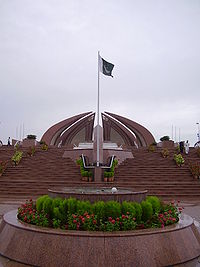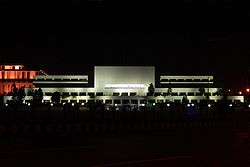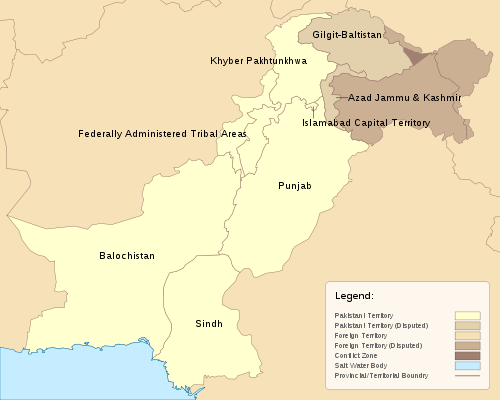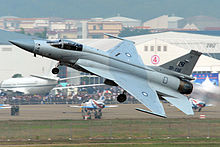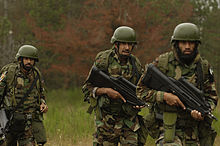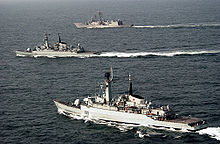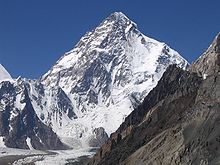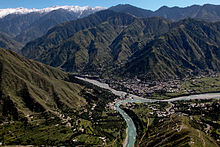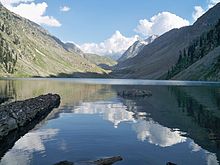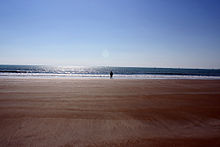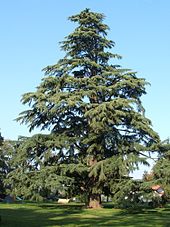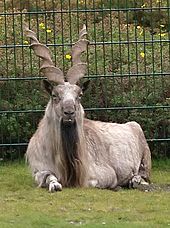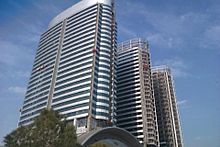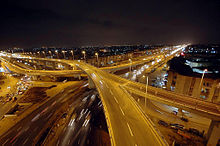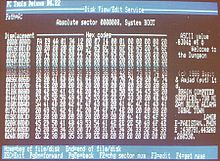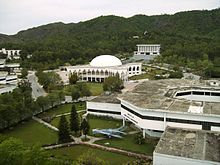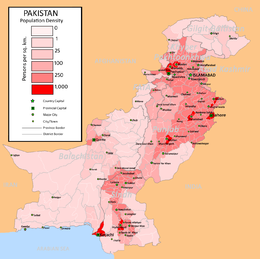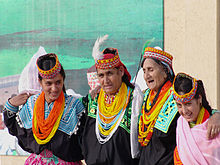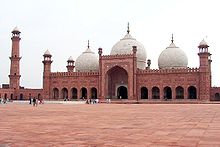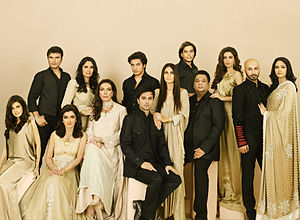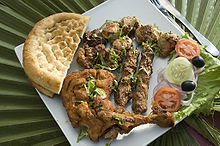
Pakistan
Did you know...
The articles in this Schools selection have been arranged by curriculum topic thanks to SOS Children volunteers. See http://www.soschildren.org/sponsor-a-child to find out about child sponsorship.
| Islamic Republic of Pakistan | ||||||
|---|---|---|---|---|---|---|
|
||||||
| Motto: ایمان ، اتحاد ، تنظیم (Urdu) Iman, Ittehad, Tanzeem "Faith, Unity, Discipline" |
||||||
| Anthem: Qaumī Tarāna |
||||||
|
Area controlled by Pakistan shown in dark green; claimed but uncontrolled territory shown in light green.
|
||||||
| Capital | Islamabad 33°40′N 73°10′E |
|||||
| Largest city | Karachi | |||||
| Official languages | ||||||
| Recognised regional languages |
|
|||||
| Demonym | Pakistani | |||||
| Government | Federal parliamentary republic | |||||
| - | President | Asif Ali Zardari | ||||
| - | Prime Minister | Raja Pervaiz Ashraf | ||||
| - | Chairman of the House | Nayyar Hussain Bukhari | ||||
| - | Speaker of the House | Fahmida Mirza | ||||
| - | Chief Justice | Iftikhar Muhammad Chaudhry | ||||
| Legislature | Majlis-e-Shoora | |||||
| - | Upper house | Senate | ||||
| - | Lower house | National Assembly | ||||
| Formation | ||||||
| - | Conception of Pakistan | 29 December 1930 | ||||
| - | Pakistan Declaration | 28 January 1933 | ||||
| - | Pakistan (Lahore) Resolution | 23 March 1940 | ||||
| - | Independence (from the United Kingdom) declared |
14 August 1947 | ||||
| - | Islamic Republic established | 23 March 1956 | ||||
| Area | ||||||
| - | Total | 796,095 km2 ( 36th) 307,374 sq mi |
||||
| - | Water (%) | 3.1 | ||||
| Population | ||||||
| - | 2012 estimate | 180,440,005 ( 6th) | ||||
| - | Density | 226.6/km2 ( 55th) 555/sq mi |
||||
| GDP ( PPP) | 2012 estimate | |||||
| - | Total | $514.559 billion ( 27th) | ||||
| - | Per capita | $2,960 | ||||
| GDP (nominal) | 2012 estimate | |||||
| - | Total | $230.525 billion ( 44th) | ||||
| - | Per capita | $$1,410 | ||||
| Gini (2005) | 31.2 medium |
|||||
| HDI (2011) | low · 145th |
|||||
| Currency | Pakistani Rupee (Rs.) ( PKR) |
|||||
| Time zone | PST ( UTC+5) | |||||
| - | Summer ( DST) | PDT ( UTC+6b) | ||||
| Drives on the | left | |||||
| Calling code | +92 | |||||
| ISO 3166 code | PK | |||||
| Internet TLD | .pk | |||||
| a. | See also Pakistani English. | |||||
| b. | Not always observed; see Daylight saving time in Pakistan. | |||||
Pakistan ( / ˈ p æ k ɨ s t æ n / or / p ɑː k i ˈ s t ɑː n /; Urdu: پاكِستان) (Urdu pronunciation: [paːkɪˈst̪aːn]), officially the Islamic Republic of Pakistan (Urdu: اسلامی جمہوریۂ پاكِستان), is a sovereign country in South Asia. With a population exceeding 180 million people, it is the sixth most populous country in the world. Located at the crossroads of the strategically important regions of South Asia, Central Asia and Western Asia, Pakistan has a 1,046-kilometre (650 mi) coastline along the Arabian Sea and the Gulf of Oman in the south and is bordered by India to the east, Afghanistan to the west and north, Iran to the southwest and China in the far northeast. It is separated from Tajikistan by Afghanistan's narrow Wakhan Corridor in the north, and also shares a marine border with Oman.
The territory of modern Pakistan was home to several ancient cultures, including the Neolithic Mehrgarh and the Bronze Age Indus Valley Civilisation, and has undergone invasions or settlements by Hindu, Persian, Indo-Greek, Islamic, Turco-Mongol, Afghan and Sikh cultures. The area has been ruled by numerous empires and dynasties, including the Indian Mauryan Empire, the Persian Achaemenid Empire, the Arab Umayyad Caliphate, the Mongol Empire, the Mughal Empire, the Durrani Empire, the Sikh Empire and the British Empire. As a result of the Pakistan Movement led by Muhammad Ali Jinnah and India's struggle for independence, Pakistan was created in 1947 as an independent nation for Muslims from the regions in the east and west of India where there was a Muslim majority. Initially a dominion, Pakistan adopted a new constitution in 1956, becoming an Islamic republic. A civil war in 1971 resulted in the secession of East Pakistan as the new country of Bangladesh.
Pakistan is a federal parliamentary republic consisting of four provinces and four federal territories. It is an ethnically and linguistically diverse country, with a similar variation in its geography and wildlife. A regional and middle power, Pakistan has the seventh largest standing armed forces in the world and is also a nuclear power as well as a declared nuclear weapons state, being the only nation in the Muslim world, and the second in South Asia, to have that status. It has a semi-industrialised economy which is the 27th largest in the world in terms of purchasing power and 47th largest in terms of nominal GDP.
Pakistan's post-independence history has been characterised by periods of military rule, political instability and conflicts with neighbouring India. The country continues to face challenging problems, including terrorism, poverty, illiteracy and corruption. It is a founding member of the Organisation of the Islamic Conference (now the Organisation of Islamic Cooperation) and is a member of the United Nations, the Commonwealth of Nations, the Next Eleven Economies, SAARC, ECO, D8 and the G20 developing nations.
Etymology
The name Pakistan literally means " Land of the Pure" in Urdu and Persian. It was coined in 1933 as Pakstan by Choudhary Rahmat Ali, a Pakistan Movement activist, who published it in his pamphlet Now or Never, using it as an acronym ("thirty million Muslim brethren who live in PAKSTAN") referring to the names of the five northern regions of the Indian subcontinent: Punjab, North-West Frontier Province (Afghan Province), Kashmir, Sindh, and Baluchistan". The letter i was incorporated to ease pronunciation and form the linguistically correct and meaningful name.
History
Early and medieval age
Some of the earliest ancient human civilisations in South Asia originated from areas encompassing present-day Pakistan. The earliest known inhabitants in the region were Soanian during the Lower Paleolithic, of whom stone tools have been found in the Soan Valley of Punjab. The Indus region, which covers most of Pakistan, was the site of several successive ancient cultures including the Neolithic Mehrgarh and the Bronze Age Indus Valley Civilisation (2800–1800 BCE) at Harappa and Mohenjo-Daro.
The Vedic Civilization (1500–500 BCE), characterised by Indo-Aryan culture, laid the foundations of Hinduism, which would become well established in the region. Multan was an important Hindu pilgrimage centre. The Vedic civilisation flourished in the ancient Gandhāran city of Takṣaśilā, now Taxila in Punjab. Successive ancient empires and kingdoms ruled the region: the Persian Achaemenid Empire around 519 BCE, Alexander the Great's empire in 326 BCE and the Maurya Empire founded by Chandragupta Maurya and extended by Ashoka the Great until 185 BCE. The Indo-Greek Kingdom founded by Demetrius of Bactria (180–165 BCE) included Gandhara and Punjab and reached its greatest extent under Menander (165–150 BCE), prospering the Greco-Buddhist culture in the region. Taxila had one of the earliest universities and centres of higher education in the world.
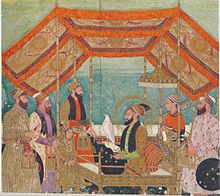
The Medieval period (642–1219 CE) is defined by the spread of Islam in the region. During this period, Sufi missionaries played a pivotal role in converting a majority of the regional Buddhist and Hindu population to Islam. The Rai Dynasty (489–632 CE) of Sindh, at its zenith, ruled this region and the surrounding territories. The Pala Dynasty was the last Buddhist empire that under Dharampala and Devapala stretched across Indian subcontinent from what is now Bangladesh through Northern India to Pakistan and later to Kamboj region in Afghanistan.
The Arab general Muhammad bin Qasim conquered Sindh and Multan in southern Punjab in 711CE. The Pakistan government's official chronology identifies this as the point where the "foundation" of Pakistan was laid. This conquest set the stage for the rule of several successive Muslim empires in the region, including the Ghaznavid Empire (975–1187 CE), the Ghorid Kingdom and the Delhi Sultanate (1206–1526 CE). The Lodi dynasty, the last of the Delhi Sultanate, was replaced by the Mughal Empire (1526–1857 CE). The Mughals introduced Persian literature and high culture, establishing the roots of Indo-Persian culture in the region.
Colonial period
The gradual decline of the Mughal Empire in the early eighteenth century enabled Sikh rulers to control large areas until the British East India Company gained ascendancy over South Asia. The Indian Rebellion of 1857, also known as the Sepoy Mutiny, was the region's major armed struggle against the British. The largely non-violent freedom struggle led by the Indian National Congress engaged millions of protesters in mass campaigns of civil disobedience in the 1920s and 1930s .
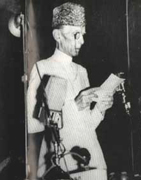
The All-India Muslim League rose to popularity in the late 1930s amid fears of under-representation and neglect of Muslims in politics. In his presidential address of 29 December 1930, Muhammad Iqbal called for "the formation of a consolidated North-West Indian Muslim State" consisting of Punjab, North-West Frontier Province, Sind and Baluchistan. Muhammad Ali Jinnah, the founder of Pakistan, espoused the two-nation theory and led the Muslim League to adopt the Lahore Resolution of 1940, popularly known as the Pakistan Resolution. In early 1947, Britain announced the decision to end its rule in India. In June 1947, the nationalist leaders of British India—including Jawaharlal Nehru and Abul Kalam Azad representing the Congress, Jinnah representing the Muslim League, and Master Tara Singh representing the Sikhs—agreed to the proposed terms of transfer of power and independence.
The modern state of Pakistan was established on 14 August 1947 (27 Ramadan 1366 in the Islamic Calendar) in the eastern and northwestern regions of British India, where there was a Muslim majority. It comprised the provinces of Balochistan, East Bengal, the North-West Frontier Province, West Punjab and Sindh. The partition of the Punjab and Bengal provinces led to communal riots across India and Pakistan; millions of Muslims moved to Pakistan and millions of Hindus and Sikhs moved to India. Dispute over the princely state of Jammu and Kashmir led to the First Kashmir War in October 1947.
Independence and Modern Pakistan
After independence, the President of the Muslim League, Mohammed Ali Jinnah, became the new nation's first Governor-General, and the Secretary General of the Muslim League, Liaquat Ali Khan became the first Prime Minister. From 1947 to 1956, Pakistan was a dominion in the Commonwealth of Nations under two monarchs. In 1947, King George VI relinquished the title of Emperor of India and became King of Pakistan. He retained that title until his death on 6 February 1952, after which Queen Elizabeth II became Queen of Pakistan. She retained that title until Pakistan became an Islamic and Parliamentary republic in 1956, but civilian rule was stalled by a military coup led by the Army Commander-in-Chief, General Ayub Khan. The country experienced exceptional growth until a second war with India took place in 1965 and led to economic downfall and internal instability. Ayub Khan's successor, General Yahya Khan (President from 1969 to 1971), had to deal with a devastating cyclone which caused 500,000 deaths in East Pakistan.
In 1970, Pakistan held its first democratic elections since independence, that were meant to mark a transition from military rule to democracy, but after the East Pakistani Awami League won, Yahya Khan and the ruling elite in West Pakistan refused to hand over power. There was civil unrest in the East, and the Pakistan Army launched a military operation on 25 March 1971, aiming to regain control of the province. The targeting of civilians and other atrocities during this operation led to a declaration of independence and to the waging of a war of liberation by the Bengali Mukti Bahini forces in East Pakistan, with support from India. However, in West Pakistan the conflict was described as a Civil War as opposed to War of Liberation.
Independent estimates of civilian deaths during this period range from 300,000 to 3 million. Attacks on Indian military bases by the Pakistan Air Force in December 1971 sparked the Indo-Pakistani War of 1971, which ended with the formal secession of East Pakistan as the independent state of Bangladesh.
With Pakistan's defeat in the war, Yahya Khan was replaced by Zulfikar Ali Bhutto as Chief Martial Law Administrator. Civilian rule resumed from 1972 to 1977. During this period Pakistan began to build nuclear weapons; the country's first atomic power plant was inaugurated in 1972. Civilian rule ended with a military coup in 1977, and in 1979 General Zia-ul-Haq became the third military president. Military government lasted until 1988, during which Pakistan became one of the fastest-growing economies in South Asia. Zia consolidated nuclear development and increased Islamization of the state. During this period, Pakistan helped to subsidise and distribute US resources to factions of the Mujahideen movement against the 1979 Soviet invasion of Afghanistan.
Zia died in a plane crash in 1988, and Benazir Bhutto, daughter of Zulfikar Ali Bhutto, was elected as the first female Prime Minister of Pakistan. She was followed by Nawaz Sharif, and over the next decade the two leaders fought for power, alternating in office while the country's situation worsened; economic indicators fell sharply, in contrast to the 1980s. This period is marked by political instability, misgovernance and corruption. In May 1998, while Sharif was Prime Minister, India tested five nuclear weapons and tension with India heightened to an extreme: Pakistan detonated six nuclear weapons of its own in the Chagai-I and Chagai-II tests later in the same month. Military tension between the two countries in the Kargil district led to the Kargil War of 1999, after which General Pervez Musharraf took over through a bloodless coup d'état and assumed vast executive powers.
Musharraf ruled Pakistan as head of state from 1999 to 2001 and as President from 2001 to 2008, a period of extensive economic reform and Pakistan's involvement in the US-led war on terrorism. On 15 November 2007, Pakistan's National Assembly became the first to completed its full five-year term, and new elections were called. After the assassination of Benazir Bhutto in December 2007, her Pakistan Peoples Party (PPP) won the largest number of seats in the 2008 elections, and party member Yousaf Raza Gillani was sworn in as Prime Minister. Musharraf resigned from the presidency on 18 August 2008 when threatened with impeachment, and was succeeded by Asif Ali Zardari, the current President. Gillani was disqualified from membership of parliament and as prime minister by the Supreme Court of Pakistan in June 2012. By its own estimates, Pakistan's involvement in the war on terrorism has cost up to $67.93 billion, thousands of casualties and nearly 3 million displaced civilians.
Politics
Pakistan is a democratic parliamentary federal republic with Islam as the state religion. The first Constitution of Pakistan was adopted in 1956 but suspended by Ayub Khan in 1958. The Constitution of 1973—suspended by Zia-ul-Haq in 1977 but reinstated in 1985—is the country's most important document, laying the foundations of the current government.
The bicameral legislature comprises a 100-member Senate and a 342-member National Assembly. The President is the head of state and commander-in-chief of the armed forces and is elected by an electoral college. The prime minister is usually the leader of the largest party in the National Assembly. Each province has a similar system of government, with a directly elected Provincial Assembly in which the leader of the largest party or alliance becomes Chief Minister. Provincial governors are appointed by the President. The Pakistani military establishment has played an influential role in mainstream politics throughout Pakistan's political history. Presidents brought in by military coups ruled in 1958–1971, 1977–1988 and 1999–2008.
Pakistan's foreign policy focuses on security against threats to national identity and territorial integrity, and on the cultivation of close relations with Muslim countries. A 2004 briefing on foreign policy for Pakistani Parliamentarians says, "Pakistan highlights sovereign equality of states, bilateralism, mutuality of interests, and non-interference in each other's domestic affairs as the cardinal features of its foreign policy." The country is an active member of the United Nations. It is a founding member of the Organisation of Islamic Cooperation (OIC), in which it has promoted Musharraf's concept of " Enlightened Moderation". Pakistan is also a member of Commonwealth of Nations, the South Asian Association for Regional Cooperation (SAARC), the Economic Cooperation Organisation (ECO) and the G20 developing nations. India's nuclear tests were seen as a threat to Pakistan and led it to establish itself as a nuclear power. Pakistan now maintains a policy of " credible minimum deterrence".
Pakistan maintains good relations with all Arab and most other Muslim countries. Since the Sino-Indian War of 1962, Pakistan's closest strategic, military and economic ally has been China. The relationship has survived changes of governments and variations in the regional and global situation. Pakistan and India continue to be rivals. The Kashmir conflict remains the major point of rift; three of their four wars were over this territory. Pakistan has had mixed relations with the United States. As an anti-Soviet power in the 1950s and during Soviet-Afghan War in the 1980s, Pakistan was one of the closest allies of the US, but relations soured in the 1990s when the US imposed sanctions because of Pakistan's possession and testing of nuclear weapons. The US war on terrorism led initially to an improvement in the relationship, but it was strained by a divergence of interests and resulting mistrust during the war in Afghanistan and by issues related to terrorism. Since 1948, there has been an ongoing, and at times fluctuating, violent conflict in the southwestern province of Balochistan between various Baloch separatist groups, who seek greater political autonomy, and the central government of Pakistan.
Foreign relations of Pakistan
Pakistan is the second largest Muslim country in terms of percentage of population (after Iran), and its status as a declared nuclear power, being the only Islamic nation to have that status, plays a part in its international role. Pakistan has a fierce independent foreign policy, especially when it comes to issues such as development of nuclear weapons, construction of nuclear reactors, foreign military purchases and other issues that are vital to its national interests. Pakistan has a strategic geo-political location at the corridor of world major maritime oil supply lines, and has close proximity to the resource and oil rich central Asian countries. Pakistan is an important member of the Organisation of Islamic Cooperation (OIC), is ranked by the US as a major non-NATO ally in the war against terrorism, and has a highly disciplined military, which is the world's eighth-largest standing military force.
Administrative divisions
Pakistan is a federation of four provinces: Punjab, Sindh, Khyber Pakhtunkhwa and Balochistan, as well as the Islamabad Capital Territory and the Federally Administered Tribal Areas in the northwest, which include the Frontier Regions. The government of Pakistan exercises de facto jurisdiction over the western parts of the disputed Kashmir region, organised into the separate political entities Azad Kashmir and Gilgit–Baltistan (formerly Northern Areas). The Gilgit–Baltistan Empowerment and Self-Governance Order of 2009 assigned a province-like status to the latter, giving it self-government.
Local government follows a three-tier system of districts, tehsils and union councils, with an elected body at each tier. There are about 130 districts altogether, of which Azad Kashmir has ten and Gilgit–Baltistan seven. The Tribal Areas comprise seven tribal agencies and six small frontier regions detached from neighbouring districts.
Law enforcement in Pakistan is carried out by federal and provincial police agencies. The four provinces and the Islamabad Capital Territory each have a civilian police force with jurisdiction limited to the relevant province or territory. At the federal level, there are a number of civilian agencies with nationwide jurisdictions; including the Federal Investigation Agency, the National Highways and Motorway Police, and several paramilitary forces such as the Pakistan Rangers and the Frontier Corps.
The court system of Pakistan is organised as a hierarchy, with the Supreme Court at the apex, below which are High Courts, Federal Shariat Courts (one in each province and one in the federal capital), District Courts (one in each district), Judicial Magistrate Courts (in every town and city), Executive Magistrate Courts and Civil Courts. Pakistan's penal code has limited jurisdiction in the Tribal Areas, where law is largely derived from tribal customs.
Military
The armed forces of Pakistan are the eighth largest in the world in terms of numbers in full-time service, with about 617,000 personnel on active duty and 513,000 reservists in 2010. They came into existence after independence in 1947, and the military establishment has frequently been involved in the politics of Pakistan ever since. The Chairman joint chiefs (the current chairman is General Shameem Wynne) is the highest principle officer in the armed forces, and the chief military adviser to the government though the chairman has no authority over the three branches of armed forces. The three main branches are the Army ( headed by General Ashfaq Parvez Kayani), the Navy ( headed by Admiral Asif Sandila), and the Air Force ( headed by Air Chief Marshal Tahir Rafique Butt), and they are supported by a number of paramilitary forces. The National Command Authority is responsible for employment, for control of the development of all strategic nuclear organisations and for Pakistan's nuclear doctrine under the nuclear defence theory. Pakistan's defence forces maintain close military relations with China and the United States and import military equipment mainly from them. The defence forces of China and Pakistan carry out joint military exercises. Conscription may be introduced in times of emergency, but it has never been imposed.
Since independence, Pakistan has been involved in four wars with neighbouring India, beginning in 1947 with the First Kashmir War, when Pakistan gained control of present-day Azad Kashmir and Gilgit–Baltistan. The two countries were at war again in 1965 and in 1971, and most recently in the Kargil War of 1999. The Army has also been engaged in several skirmishes with Afghanistan on the western border: in 1961, it repelled a major Afghan incursion. During the Soviet war in Afghanistan, Pakistan shot down several intruding pro-Soviet Afghan communist aircraft and provided covert support to factions of the Afghan mujahideen through the Inter-Services Intelligence agency.
Apart from its own conflicts, Pakistan has been an active participant in United Nations peacekeeping missions. It played a major role in rescuing trapped American soldiers from Mogadishu, Somalia, in 1993 in Operation Gothic Serpent. Pakistani armed forces are the largest troop contributors to UN peacekeeping missions.
Pakistan maintained significant numbers of troops in some Arab countries in defence, training and advisory roles. During the Six-Day War in 1967 and the Yom Kippur War in October 1973, PAF pilots volunteered to go to the Middle East to support Egypt and Syria, which were in a state of war with Israel; they shot down ten Israeli planes in the Six-Day War. In 1979, at the request of the Saudi government, commandos of the Pakistani Special Service Group were rushed to assist Saudi forces in Mecca to lead the operation of the Grand Mosque Seizure. In 1991 Pakistan got involved with the Gulf War and sent 5,000 troops as part of a US-led coalition, specifically for the defence of Saudi Arabia.
Pakistani armed forces have been engaged in a war in North-West Pakistan since 2001, mainly against the Tehrik-i-Taliban Pakistan. Major operations undertaken by the Army include Operation Black Thunderstorm and Operation Rah-e-Nijat.
Kashmir conflict
The Kashmir conflict is a territorial dispute between India and Pakistan over the Kashmir region, the most northwesterly region of South Asia. The two countries have fought at least three wars over Kashmir—the Indo-Pakistani Wars of 1947, 1965 and 1999—and several skirmishes over the Siachen Glacier. India claims the entire state of Jammu and Kashmir and administers approximately 45.1% of the region, including most of Jammu, the Kashmir Valley, Ladakh, and the Siachen Glacier. India's claim is contested by Pakistan, which controls approximately 38.2% of Kashmir, consisting of Azad Kashmir and the northern areas of Gilgit and Baltistan.
The conflict of Kashmir has its origin in 1947, when British India was separated into the two states of Pakistan and India. As part of the partition process, both countries had agreed that the rulers of princely states would be allowed to opt for membership of either Pakistan or India, or in special cases to remain independent. India claims Kashmir on the basis of the Instrument of Accession, a legal agreement with Kashmir's leaders executed by Maharaja Hari Singh, then ruler of Kashmir, agreeing to accede the area to India. Pakistan claims Kashmir on the basis of a Muslim majority and of geography, the same principles that were applied for the creation of the two independent states. India referred the dispute to the United Nations on 1 January 1948. In a resolution in 1948, the UN asked Pakistan to remove most of its troops. A plebiscite would then be held. However, Pakistan failed to vacate the region. A ceasefire was reached in 1949 and a Line of Control was established, dividing Kashmir between the two countries.
Pakistan's position is that the people of Jammu and Kashmir have the right to determine their future through impartial elections as mandated by the United Nations. India has stated that it believes that Kashmir is an integral part of India, referring to the 1972 Simla Agreement and to the fact that elections take place regularly. Certain Kashmiri independence groups believe that Kashmir should be independent of both India and Pakistan.
Geography and climate
Pakistan covers an area of 796,095 km2 (307,374 sq mi), approximately equal to the combined land areas of France and the United Kingdom. It is the 36th largest nation by total area, although this ranking varies depending on how the disputed territory of Kashmir is counted. Pakistan has a 1,046 km (650 mi) coastline along the Arabian Sea and the Gulf of Oman in the south and land borders of 6,774 km (4,209 mi) in total: 2,430 km (1,510 mi) with Afghanistan, 523 km (325 mi) with China, 2,912 km (1,809 mi) with India and 909 km (565 mi) with Iran. It shares a marine border with Oman, and is separated from Tajikistan by the cold, narrow Wakhan Corridor. Pakistan occupies a geopolitically important location at the crossroads of South Asia, the Middle East and Central Asia.
Geologically, Pakistan overlaps the Indian tectonic plate in its Sindh and Punjab provinces; Balochistan and most of Khyber Pakhtunkhwa are within the Eurasian plate, mainly on the Iranian plateau. Gilgit–Baltistan and Azad Kashmir lie along the edge of the Indian plate and hence are prone to violent earthquakes. Ranging from the coastal areas of the south to the glaciated mountains of the north, Pakistan's landscapes vary from plains to deserts, forests, hills and plateaus .
Pakistan is divided into three major geographic areas: the northern highlands, the Indus River plain and the Balochistan Plateau. The northern highlands contain the Karakoram, Hindu Kush and Pamir mountain ranges (see mountains of Pakistan), which contain some of the world's highest peaks, including five of the fourteen eight-thousanders (mountain peaks over 8,000 metres or 26,250 feet), which attract adventurers and mountaineers from all over the world, notably K2 (8,611 m or 28,251 ft) and Nanga Parbat (8,126 m or 26,660 ft). The Balochistan Plateau lies in the west and the Thar Desert in the east. The 1,609 km (1,000 mi) Indus River and its tributaries flow through the country from the Kashmir region to the Arabian Sea. There is an expanse of alluvial plains along it in Punjab and Sindh.
The climate varies from tropical to temperate, with arid conditions in the coastal south. There is a monsoon season with frequent flooding due to heavy rainfall, and a dry season with significantly less rainfall or none at all. There are four distinct seasons: a cool, dry winter from December through February; a hot, dry spring from March through May; the summer rainy season, or southwest monsoon period, from June through September; and the retreating monsoon period of October and November. Rainfall varies greatly from year to year, and patterns of alternate flooding and drought are common.
Flora and fauna
The diversity of landscapes and climates in Pakistan allows a wide variety of trees and plants to flourish. The forests range from coniferous alpine and subalpine trees such as spruce, pine and deodar cedar in the extreme northern mountains, through deciduous trees in most of the country (for example the mulberry-like shisham found in the Sulaiman Mountains), to palms such as coconut and date in southern Punjab, southern Balochistan and all of Sindh. The western hills are home to juniper, tamarisk, coarse grasses and scrub plants. Mangrove forests form much of the coastal wetlands along the coast in the south.
Coniferous forests are found at altitudes ranging from 1,000 to 4,000 metres in most of the northern and northwestern highlands. In the xeric regions of Balochistan, date palm and Ephedra are common. In most of Punjab and Sindh, the Indus plains support tropical and subtropical dry and moist broadleaf forestry as well as tropical and xeric shrublands. These forests are mostly of mulberry, acacia, and eucalyptus. About 2.2% or 1,687,000 hectares (16,870 km2) of Pakistan was forested in 2010.
The fauna of Pakistan reflects its varied climates too. Around 668 bird species are found there: crows, sparrows, mynas, hawks, falcons, and eagles commonly occur. Palas, Kohistan, has a significant population of Western Tragopan. Many birds sighted in Pakistan are migratory, coming from Europe, Central Asia and India.
The southern plains are home to mongooses, civets, hares, the Asiatic jackal, the Indian pangolin, the jungle cat and the desert cat. There are mugger crocodiles in the Indus, and wild boar, deer, porcupines and small rodents are common in the surrounding areas. The sandy scrublands of central Pakistan are home to Asiatic jackals, striped hyenas, wildcats and leopards. The lack of vegetative cover, the severe climate and the impact of grazing on the deserts have left wild animals in a precarious position. The chinkara is the only animal that can still be found in significant numbers in Cholistan. A small number of nilgai are found along the Pakistan-India border and in some parts of Cholistan. A wide variety of animals live in the mountainous north, including the Marco Polo sheep, the urial (a subspecies of wild sheep), Markhor and Ibex goats, the Asian black bear and the Himalayan brown bear. Among the rare animals found in the area are the snow leopard, the Asiatic cheetah and the blind Indus river dolphin, of which there are believed to be about 1,100 remaining, protected at the Indus River Dolphin Reserve in Sindh. In total, 174 mammals, 177 reptiles, 22 amphibians, 198 freshwater fish species and 5,000 species of invertebrates (including insects) have been recorded in Pakistan.
The flora and fauna of Pakistan suffer from a number of problems. Pakistan has the second-highest rate of deforestation in the world. This, along with hunting and pollution, is causing adverse effects on the ecosystem. The government has established a large number of protected areas, wildlife sanctuaries, and game reserves to deal with these issues.
Infrastructure
Economy
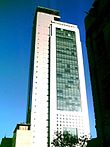
Pakistan is a rapidly developing country and is one of the Next Eleven, the eleven countries that, along with the BRICs, have a high potential to become the world's largest economies in the 21st century. The economy is semi-industrialized, with centres of growth along the Indus River. The diversified economies of Karachi and Punjab's urban centres coexist with less developed areas in other parts of the country. Pakistan's estimated nominal GDP as of 2011 is US$202 billion. The GDP by PPP is US$488.6 billion. The estimated nominal per capita GDP is US$1,197, GDP (PPP) per capita is US$2,851 ( international dollars), and debt-to-GDP ratio is 55.5%. A 2010 report by RAD-AID positioned Pakistan's economy at 27th largest in the world by purchasing power and 45th largest in absolute dollars. It is South Asia's second largest economy, representing about 15 percent of regional GDP.
Pakistan's economic growth since its inception has been varied. It has been slow during periods of civilian rule, but excellent during the three periods of military rule, although the foundation for sustainable and equitable growth was not formed. The early to middle 2000s was a period of rapid reform; the government raised development spending, which reduced poverty levels by 10% and increased GDP by 3%. The economy cooled again from 2007. Inflation reached 25% in 2008 and Pakistan had to depend on an aggressive fiscal policy backed by the International Monetary Fund to avoid possible bankruptcy. A year later, the Asian Development Bank reported that Pakistan's economic crisis was easing. The inflation rate for the fiscal year 2010–11 was 14.1%.
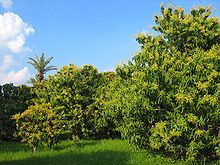
Pakistan is one of the largest producers of natural commodities, and its labour market is the 10th largest in the world. Around 600,000 Pakistanis went abroad to work in 2009. Expatriate workers send remittances of close to US$8 billion annually—the largest source of foreign exchange apart from exports. According to the World Trade Organization Pakistan's share of overall world exports is declining; it contributed only 0.128% in 2007. The trade deficit in the fiscal year 2010–11 was US$11.217 billion.
The structure of the Pakistani economy has changed from a mainly agricultural to a strong service base. Agriculture now accounts for only 21.2% of the GDP. Even so, according to the United Nations Food and Agriculture Organization, Pakistan produced 21,591,400 metric tons of wheat in 2005, more than all of Africa (20,304,585 metric tons) and nearly as much as all of South America (24,557,784 metric tons). Between 2002 and 2007 there was substantial foreign investment in Pakistan's banking and energy sectors. Other important industries include clothing and textiles (accounting for nearly 60% of exports), food processing, chemicals manufacture, iron and steel. There is great potential for tourism in Pakistan, but it is severely affected by the country's instability.
Transport
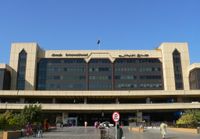
The transport sector accounts for 10.5% of Pakistan's GDP. Its road infrastructure is better than those of India, Bangladesh and Indonesia, but the rail system lags behind those of India and China, and aviation infrastructure also needs improvement. There is scarcely any inland water transportation system, and coastal shipping only meets minor local requirements.
Roads form the backbone of Pakistan's transport system; a total road length of 259,618 km accounts for 91% of passenger and 96% of freight traffic. Road transport services are largely in the hands of the private sector, which handles around 95% of freight traffic. The National Highway Authority is responsible for the maintenance of national highways and motorways. The highway and motorway system depends mainly on north–south links, connecting the southern ports to the populous provinces of Punjab and NWFP. Although this network only accounts for 4.2% of total road length, it carries 85 percent of the country's traffic.
Pakistan Railways, under the Ministry of Railways, operates the railroad system. Rail was the primary means of transport till 1970. In the two decades from around 1990, there was a marked shift in traffic from rail to highways. Now the railway's share of inland traffic is only 10% for passengers and 4% for freight traffic. The total rail track decreased from 8,775 km in 1990–91 to 7,791 km in 2011. Pakistan expects to use the rail service to boost foreign trade with China, Iran and Turkey.
Pakistan had 35 airports in 2007–8. The state-run Pakistan International Airlines is the major airline; it carries about 73% of domestic passengers and all domestic freight. Karachi's Jinnah International Airport is the principal international gateway to Pakistan, although Islamabad and Lahore also handle significant amounts of traffic. Pakistan's major seaports are Karachi, Muhammad bin Qasim and Gwadar, which is still under construction.
Science and technology
Pakistan is active in physics and mathematics research. Every year, scientists from around the world are invited by the Pakistan Academy of Sciences and the Pakistan Government to participate in the International Nathiagali Summer College on Physics. Pakistan hosted an international seminar on Physics in Developing Countries for International Year of Physics 2005. Pakistani theoretical physicist Abdus Salam won a Nobel Prize in Physics for his work on the electroweak interaction.
In medicine, Salimuzzaman Siddiqui was the first Pakistani scientist to bring the therapeutic constituents of the Neem tree to the attention of natural products chemists. Pakistani neurosurgeon Ayub Ommaya invented the Ommaya reservoir, a system for treatment of brain tumours and other brain conditions.
Pakistan has an active space program led by its space research agency, SUPARCO. Polish-Pakistani aerospace engineer W. J. M. Turowicz developed and supervised the launch of the Rehbar-I rocket from Pakistani soil, making Pakistan the first South Asian country to launch a rocket into space. Pakistan launched its first satellite, Badr-I, from China in 1990, becoming the first Muslim country and second South Asian country to put a satellite into space. In 1998, Pakistan became the seventh country in the world to successfully develop its own nuclear weapons.
Pakistan is one of a small number of countries that have an active research presence in Antarctica. The Pakistan Antarctic Programme was established in 1991. Pakistan has two summer research stations on the continent and plans to open another base, which will operate all year round.
Electricity in Pakistan is generated and distributed by two vertically integrated public sector utilities: the Karachi Electric Supply Corporation (KESC) for Karachi and the Water and Power Development Authority (WAPDA) for the rest of Pakistan. Nuclear power in Pakistan is provided by three licensed commercial nuclear power plants under Pakistan Atomic Energy Commission (PAEC). Pakistan is the first Muslim country in the world to embark on a nuclear power program. Commercial nuclear power plants generate roughly 3% of Pakistan's electricity, compared with about 64% from thermal and 33% from hydroelectric power.
Education
The constitution of Pakistan requires the state to provide free primary and secondary education. At the time of independence Pakistan had only one university, the University of the Punjab. As of September 2011 it has 136 universities, of which 74 are public universities and 62 are private universities. It is estimated that there are 3193 technical and vocational institutions in Pakistan, and there are also madrassahs that provide free Islamic education and offer free board and lodging to students, who come mainly from the poorer strata of society. After criticism over terrorists' use of madrassahs for recruitment, efforts have been made to regulate them.
Education in Pakistan is divided into six main levels: pre-primary (preparatory classes); primary (grades one through five); middle (grades six through eight); high (grades nine and ten, leading to the Secondary School Certificate); intermediate (grades eleven and twelve, leading to a Higher Secondary (School) Certificate); and university programmes leading to graduate and postgraduate degrees. Pakistani private schools also operate a parallel secondary education system based on the curriculum set and administered by the Cambridge International Examinations. Some students choose to take the O level and A level exams conducted by the British Council.
The government is in a development stage, in which it is extending English medium education to all schools across the country. Meanwhile, by 2013 all educational institutions in Sindh will have to provide Chinese language courses, reflecting China's growing role as a superpower and Pakistan's close ties with China.
The literacy rate of the population above ten years of age in the country is 58.5%. Male literacy is 70.2% while female literacy rate is 46.3%. Literacy rates vary by region and particularly by sex; for instance, female literacy in tribal areas is 3%. The government launched a nationwide initiative in 1998 with the aim of eradicating illiteracy and providing a basic education to all children. Through various educational reforms, by 2015 the ministry of education expects to attain 100% enrolment levels among children of primary school age and a literacy rate of 86% among people aged over 10.
Demographics
With 180.1 million residents reported in 2012, Pakistan is the sixth most populated country in the world, behind Brazil and ahead of Bangladesh. Its 2.03% population growth rate is the highest among the SAARC countries and gives an annual increase of 3.6 million. The population is projected to reach 210.13 million by 2020 and to double by 2045. In 1947, Pakistan had a population of 32.5 million. From 1990 to 2009 it increased by 57.2%. By 2030 it is expected to surpass Indonesia as the largest Muslim-majority country in the world. Pakistan is a 'young' nation, with a median age of about 22 and 104 million people under 30 in 2010. Pakistan's fertility rate stands at 3.07, higher than its neighbours India(2.57) and Iran(1.73). Around 35% of the people are under 15
The majority of southern Pakistan's population lives along the Indus River. Karachi is its most populous city. In the northern half of the country, most of the population lives in an arc formed by the cities of Lahore, Faisalabad, Rawalpindi, Islamabad, Gujranwala, Sialkot, Gujrat, Jhelum, Sargodha, Sheikhupura, Nowshera, Mardan and Peshawar. During 1990–2008, city dwellers made up 36% of Pakistan's population, making it the most urbanised nation in South Asia. Furthermore, 50% of Pakistanis live in towns of 5,000 people or more.
Expenditure on health was 2.6% of GDP in 2009. Life expectancy at birth was 65.4 years for females and 63.6 years for males in 2010. The private sector accounts for about 80% of outpatient visits. Approximately 19% of the population and 30% of children under five are malnourished. Mortality of the under-fives was 87 per 1,000 live births in 2009. About 20% of the population live below the international poverty line of US$1.25 a day.
More than sixty languages are spoken in Pakistan, including a number of provincial languages. Urdu, the lingua franca and a symbol of Muslim identity and national unity, is the national language and is understood by over 75% of Pakistanis. English is the official language of Pakistan, used in official business, government, and legal contracts; the local dialect is known as Pakistani English. Punjabi is the most common native language in Punjab and has many native speakers. Saraiki is mainly spoken in South Punjab. Pashto is the provincial language of Khyber Pakhtunkhwa, Sindhi is the provincial language of Sindh, and Balochi is dominant in Balochistan.
| Largest cities or towns of Pakistan 2012 estimate |
|||||||||
|---|---|---|---|---|---|---|---|---|---|
| Rank | City name | Province | Pop. | Rank | City name | Province | Pop. | ||
 Karachi
|
1 | Karachi | Sindh | 11,136,886 | 11 | Sargodha | Punjab | 593,463 |  Faisalabad |
| 2 | Lahore | Punjab | 6,658,393 | 12 | Sialkot | Punjab | 545,646 | ||
| 3 | Faisalabad | Punjab | 2,600,525 | 13 | Bahawalpur | Punjab | 528,678 | ||
| 4 | Rawalpindi | Punjab | 1,824,983 | 14 | Sukkur | Sindh | 400,148 | ||
| 5 | Multan | Punjab | 1,550,046 | 15 | Jhang | Punjab | 379,770 | ||
| 6 | Gujranwala | Punjab | 1,466,063 | 16 | Sheikhupura | Punjab | 362,808 | ||
| 7 | Hyderabad | Sindh | 1,391,534 | 17 | Mardan | Khyber Pakhtunkhwa | 326,132 | ||
| 8 | Peshawar | Khyber Pakhtunkhwa | 1,303,351 | 18 | Gujrat | Punjab | 325,952 | ||
| 9 | Islamabad | Capital Territory | 1,082,262 | 19 | Larkana | Sindh | 322,315 | ||
| 10 | Quetta | Balochistan | 842,410 | 20 | Kasur | Punjab | 317,575 | ||
The population comprises several ethnic groups. As of 2009, the Punjabi population dominates with 78.7 million (44.15%), followed by 27.2 million (15.42%) Pashtuns, 24.8 million (14.1%) Sindhis, 14.8 million (10.53%) Seraikis, 13.3 million (7.57%) Muhajirs and 6.3 million (3.57%) Balochs. The remaining 11.1 million (4.66%) belong to various ethnic minorities. There is also a large worldwide Pakistani diaspora, numbering over seven million.
Pakistan's census does not include immigrant groups such as the 1.7 million registered refugees from neighbouring Afghanistan, who are found mainly in the Khyber Pakhtunkhwa and FATA areas, with small numbers in Karachi and Quetta. As of 1995, there were more than 1.6 million Bengalis, 650,000 Afghans, 200,000 Burmese, 2,320 Iranians and Filipinos and hundreds of Nepalese, Sri Lankans and Indians living in Karachi. Pakistan hosts more refugees than any other country in the world.
Religion
Pakistan is the second most populous Muslim-majority country and has the second largest Shi'a population in the world. About 97% of Pakistanis are Muslim. The majority are Sunni, with an estimated 5–20% Shi'a. A further 2.3% are Ahmadis, who are officially considered non-Muslims by virtue of a 1974 constitutional amendment. There are also several Quraniyoon communities. sectarian violence among Muslim denominations has increased in recent times with over 400 targeted deaths of Shias in the year 2012 alone. After the Quetta blast in 2013 there were country wide protest by Shia Muslims supported by fellow Sunni Muslims calling an end to sectarian violence in the country and urging for Shia-Sunni unity in the country.
Sufism, a mystical Islamic tradition, has a long history and a large popular following in Pakistan. Popular Sufi culture is centered on Thursday night gatherings at shrines and annual festivals which feature Sufi music and dance. Contemporary Islamic fundamentalists criticize its popular character, which in their view, does not accurately reflect the teachings and practice of the Prophet and his companions. There have been terrorist attacks directed at Sufi shrines and festivals, five in 2010 that killed 64 people.
After Islam, Hinduism and Christianity are the largest religions in Pakistan, each with 2,800,000 (1.6%) adherents in 2005. They are followed by the Bahá'í Faith, which has a following of 30,000, then Sikhism, Buddhism and Parsis, each claiming 20,000 adherents, and a very small community of Jains.
Culture and society
Pakistani society is largely hierarchical, emphasising local cultural etiquettes and traditional Islamic values that govern personal and political life. The basic family unit is the extended family, although there has been a growing trend towards nuclear families for socio-economic reasons. The traditional dress for both men and women is the Shalwar Kameez; trousers and shirts are also popular among men. The middle class has increased to around 30 million and the upper and upper-middle classes to around 17 million in recent decades, and power is shifting from rural landowners to the urbanised elites. Pakistani festivals like Eid ul-Fitr, Eid al-Adha and Ramadan are mostly religious in origin. Increasing globalisation has resulted in Pakistan ranking 56th on the A.T. Kearney/FP Globalization Index.
Clothing and fashion
The shalwar kameez is the national dress of Pakistan and is worn by men and women in all four provinces Punjab, Sindh, Baluchistan, Khyber Pakhtoonkhwa and FATA in the country and in Azad Kashmir. Each province has its own style of wearing the Shalwar Qameez. Pakistanis wairclothes range from exquisite colors and designs to the type of fabric ( silk, chiffon, cotton, etc.).
Pakistani fashion has flourished well in the changing environment of fashion world. Since Pakistan came into being its fashion has been historically evolved from different phases and made its unique identity apart from Indian fashion and culture. At this time, Pakistani fashion is a combination of traditional and modern dresses and it has become the cultural identification of Pakistan. Despite of all modern trends, the regional and traditional dresses have developed their own significance as a symbol of native tradition. This regional fashion is not static but evolving into more modern and pure forms.
Pakistan Fashion Design Council based in Lahore organizes Fashion Week and Fashion Pakistan based in Karachi organizes fashion shows in that city. Credit goes to Ayesha Tammy Haq, a British-trained lawyer and chief executive of Fashion Pakistan, who came up with the idea for Pakistan’s first fashion week, held in November 2009.
Literature
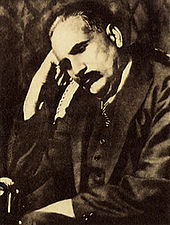
Pakistan has literature in Urdu, Sindhi, Punjabi, Pushto, Baluchi, Persian, English and many other languages. Before the 19th century it consisted mainly of lyric and religious poetry, mystical and folkloric works. During the colonial age, native literary figures influenced by western literary realism took up increasingly varied topics and narrative forms. Prose fiction is now very popular.
The national poet of Pakistan, Muhammad Iqbal, wrote poetry in Urdu and Persian and is read in Afghanistan, Iran, Indonesia, India and the Arab world. He was a strong proponent of the political and spiritual revival of Islamic civilisation and encouraged Muslims binding all over the world to bring about successful revolution.
Well-known representatives of contemporary Pakistani Urdu literature include Faiz Ahmed Faiz. Sadequain is known for his calligraphy and paintings. Sufi poets Shah Abdul Latif, Bulleh Shah, Mian Muhammad Bakhsh and Khawaja Farid are very popular in Pakistan. Mirza Kalich Beg has been termed the father of modern Sindhi prose.
Architecture
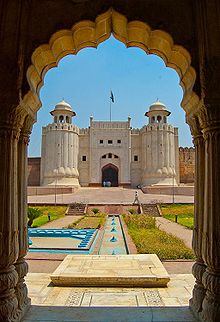
Pakistani architecture has four recognised periods: pre-Islamic, Islamic, colonial and post-colonial. With the beginning of the Indus civilisation around the middle of the 3rd millennium BCE, an advanced urban culture developed for the first time in the region, with large buildings, some of which survive to this day. Mohenjo Daro, Harappa and Kot Diji are among the pre-Islamic settlements that are now tourist attractions. The rise of Buddhism and the Persian and Greek influence led to the development of the Greco-Buddhist style, starting from the 1st century CE. The high point of this era was reached at the peak of the Gandhara style. An example of Buddhist architecture is the ruins of the Buddhist monastery Takht-i-Bahi in Khyber Pakhtunkhwa.
The arrival of Islam in today's Pakistan meant a sudden end of Buddhist architecture in the area and a smooth transition to the predominantly pictureless Islamic architecture. The most important Persian-style building still standing is the tomb of the Shah Rukn-i-Alam in Multan. During the Mughal era, design elements of Persian-Islamic architecture were fused with and often produced playful forms of Hindustani art. Lahore, occasional residence of Mughal rulers, exhibits many important buildings from the empire. Most prominent among them are the Badshahi mosque, the fortress of Lahore with the famous Alamgiri Gate, the colourful, Persian-style Wazir Khan Mosque, the Shalimar Gardens in Lahore and the Shahjahan Mosque in Thatta. In the British colonial period, predominantly functional buildings of the Indo-European representative style developed from a mixture of European and Indian-Islamic components. Post-colonial national identity is expressed in modern structures like the Faisal Mosque, the Minar-e-Pakistan and the Mazar-e-Quaid.
Cuisine
Pakistani cuisine is a blend of cooking traditions from different regions of the Indian subcontinent, originating from the royal kitchens of sixteenth-century Mughal emperors. It has similarities to North Indian cuisine, although Pakistan has a greater variety of meat dishes. Pakistani cooking uses large quantities of spices, herbs and seasoning. Garlic, ginger, turmeric, red chilli and garam masala are used in most dishes, and home cooking regularly includes curry. Chapati, a thin flat bread made from wheat, is a staple food, served with curry, meat, vegetables and lentils. Rice is also common; it is served plain or fried with spices and is also used in sweet dishes. Lassi is a traditional drink in the Punjab region. Black tea with milk and sugar is popular throughout Pakistan and is taken daily by most of the population.
Sports
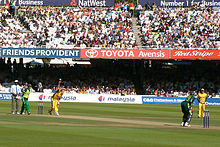
The national sport of Pakistan is hockey, in which it has earned 8 of its 10 Olympic medals, including three gold medals (1960, 1968, and 1984). Pakistan has also won the Hockey World Cup a record four times (1971, 1978, 1982, 1994).
Cricket, however, is the most popular game across the country. The national cricket team has won the Cricket World Cup once (in 1992), been runners-up once (in 1999), and co-hosted the tournament twice (in 1987 and 1996). Pakistan were runners-up in the inaugural 2007 ICC World Twenty20 in South Africa and won the 2009 ICC World Twenty20 in England. Lately, however, Pakistani cricket has suffered severely because teams have refused to tour Pakistan for fear of terrorism. No teams have toured Pakistan since March 2009, when militants attacked the touring Sri Lankan cricket team.
In Squash, world-class players such as Jahangir Khan, widely considered the greatest player in the sport's history,, and Jansher Khan won the World Open Squash Championship several times during their careers. Jahangir Khan also won the British Open a record ten times. Pakistan has competed many times at the Olympics in field hockey, boxing, athletics, swimming, and shooting. Pakistan's Olympic medal tally stands at 10 of which 8 were earned in hockey. The Commonwealth Games and Asian Games medal tallies stand at 65 and 160 respectively.
At national level, football and polo are popular, with regular national events in different parts of the country. Boxing, billiards, snooker, rowing, kayaking, caving, tennis, contract bridge, golf and volleyball are also actively pursued, and Pakistan has produced regional and international champions in these sports.



